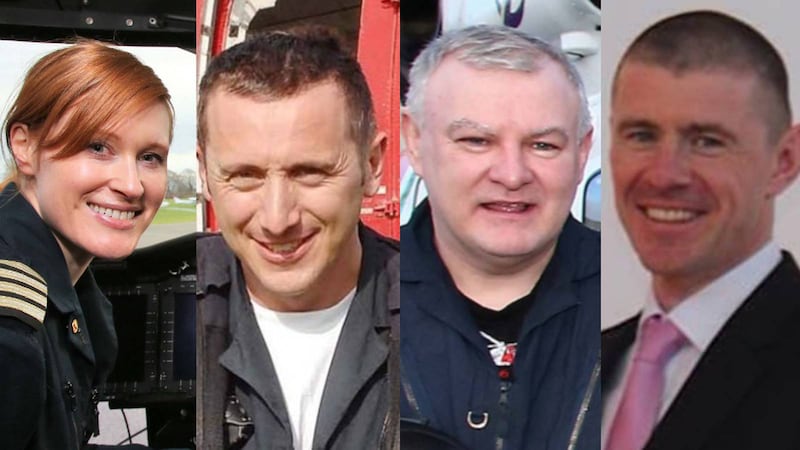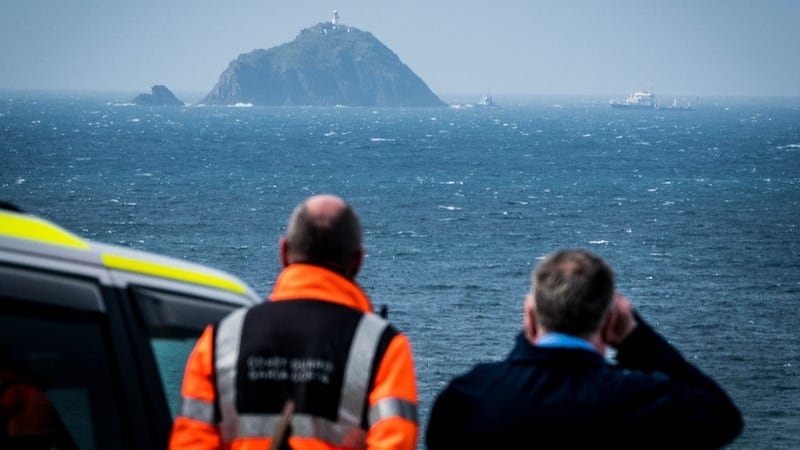The jury at the inquest into the R116 helicopter crash, which resulted in the death of crew members pilot Capt Dara Fitzpatrick, co-pilot Capt Mark Duffy, and winchmen Paul Ormsby and Ciaran Smith, has been told to reach a verdict of accidental death or death by misadventure.
They started deliberations briefly on Wednesday afternoon before retiring for the night and will resume on Thursday morning.
Mayo coroner Dr Eleanor Fitzgerald said misadventure was akin to someone drinking too much then going swimming and drowning; while she likened accidental death to straightforward drowning.
There was surprise at the speed with which the inquest proceeded from its resumption on Wednesday morning. Dr Fitzgerald had set aside three days but, in the event, the jury heard from 23 witnesses, two by video link, and a further nine at an earlier sitting in 2018.
No more witnesses were due to be called and lawyers for the families of the deceased, and various interested parties, such as the Coast Guard, made no closing submissions or legal arguments ahead of the jury retiring.
Earlier, Ian Scott, a radio officer at Malin Head in Donegal, defended his decision to call for the medical evacuation of a fisherman with an injured thumb some 180 nautical miles west of Blacksod Lighthouse in Co Mayo.
The doctor to whom he spoke told the inquest that she would not have sent the helicopter because the injury was minor and, in any event, the thumb could not have been saved. The mission to airlift the trawlerman resulted ultimately in the loss of R116 and its four person crew in March 2017.
Mr Scott had been radioed by William Buchanan, the captain of a Scottish trawler, the King’s Cross, that was fishing in the Atlantic at the Porcupine Bank to say that a crew member, James John Strachen, had injured himself. He said he was told that “blood was spurting” from the man’s severed thumb and that a hospital was 14 hours away. When the doctor he consulted asked if he was taking the man off the vessel and he said yes, she did not object, said Mr Scott.
“It was clear to me, using my judgment. . . [and] it became clear time that the doctor at no time . . . disagreed with that decision. It is my opinion that the man needed taking off the vessel,” he added. “If I had to make the decision today, I’d make the same decision. I don’t know what happened the guy and I hope everything went well for him.”
Was it a life and death situation, the coroner asked after Mr Scott’s deposition was read into the record. It could have been, he said.
“I’m thinking this man’s bleeding, this man’s in pain,” he said.
Mr Buchanan said those on the trawler had fished blue whiting for five or six hours and at 9.15pm began to haul in. It was then that Mr Strachen’s hand got caught and his thumb became stuck. He got Mr Strachen’s hand out of his glove but half of his thumb was crushed and left inside it. They retrieved the thumb top and put into a freezer.
He called the Coast Guard and explained the injuries. He was transferred to a doctor who advised on cleaning the wound. That doctor, Dr Mai Nguyen, an emergency registrar at Cork University Hospital, confirmed that she spoke to the trawler captain and radio operator.
In a deposition, she described the injury for which the helicopters R118 and R116 were scrambled, as “minor”.
“In my own mind, the fact that the thumb was severed and they were so far from the coast, I felt there was no hope of reattaching the thumb anyway,” she said in her deposition.
[ Rescue 116: Timeline of a tragedyOpens in new window ]
She said she felt terrible the next day when she heard news of the R116 crash and the loss of its crew.
“I wouldn’t have made that decision myself anyway, I would have contacted my consultant first for a second opinion,” she said. “I personally felt the injury was minor in nature and wouldn’t have sent the Coast Guard out there because the thumb couldn’t have been saved.”
Questioned, via video link, by Colm Ó hOisín, SC for the Coast Guard, Dr Nguyen said she remembered that on the night, she thought dispatching “was probably an excessive thing” but it was not her decision to take.
Mr Ó hOisín said that recordings of her conversation between the trawler and radio operator did not contain this opinion from her.
“I was told that the helicopter was already dispatched,” she replied. “I was a first year registrar and I really didn’t have the power to stop A helicopter making that journey. Our job is to provide medical oversight.”
Re-opening the inquest after an initial hearing in April 2018 which was adjourned to facilitate garda and air accident investigations, Dr Fitzgerald, thanked those investigators and noted that the “families have been through so much already it is high time that we have got here today”.

The inquest would examine events relating to all four deceased together but issue individual findings for each one, she said. The cause of death was known but the “how, when and where” was to be established.
The crew of R116 had provided what is known as top cover for colleagues in another Coast Guard helicopter, R118, during the medical evacuation of the injured fisherman who was some 140 nautical miles west of Eagle Island. Top cover is where a second aircraft remains above another, observing an operation, helping with communications and ready to assist if needed.
Once the operation was completed, R118 headed back towards the mainland with the stricken trawlerman, while R116 advised Air Traffic Control (ATC) at Shannon that it was flying to Blacksod lighthouse to refuel. However, at around 12.45 am it disappeared from radar and never reached the lighthouse.
A search and rescue operation was launched, including involving R118 which turned back to assist, along with R115, dispatched from Shannon, the Naval Service and the Royal National Lifeboat Service (RNLI).
It soon became apparent that R116, while approaching Blacksod lighthouse, had clipped Blackrock Island, some 13km west of the Mullet peninsula, and crashed into the sea on its approach to the lighthouse, with the loss of all on board.
The inquest had heard previously that the body of Capt Dara Fitzpatrick was recovered from the water by the RNLI Achill lifeboat, southeast of Blackrock island at 2.37am on the day of the crash, just under two hours after the last recorded contact with Rescue 116.
The body of co-pilot Capt Mark Duffy was recovered March 26th in about 36m of water some 100m from Blackrock island. The bodies of winchmen Paul Ormsby and Ciarán Smith have never been recovered and are listed officially as lost at sea.
The resumed inquest also heard from Achill lifeboat crewman Michael O’Hara. He described receiving an emergency alert, going to the lifeboat and setting to sea with colleagues on their rescue mission. After a time, the saw a helicopter, R115 which had been dispatched from Shannon to assist in the search and rescue effort for the missing R116, hovering over water, its light shining on a floating body.
He could see it was a woman, he said in his deposition. She was taken from the water and placed on the lifeboat’s deck.
He and a colleague removed an inflated life jacket to allow them perform cardiopulmonary resuscitation (CPR). The woman, Capt Fitzpatrick, had a fixed stare, her hands were cold and she was missing her helmet. Mr O’Hara and his colleague took turns doing chest compressions and mouth-to-mouth resuscitation but to no avail. Mr O’Hara had to hold onto his colleague at times because of the strong sea swell.

Mr O’Hara said they ceased their efforts at reviving Capt Fitzpatrick when it was clear “we had done our best and there was nothing more we could do for her”.
A winchman was lowered from R115 and Capt Fitzpatrick’s body was removed to Mayo University Hospital in Castlebar.
Dr Fitzgerald commended Mr O’Hara for his bravery and the speed of his response on the night.
Paul Farrell, the Air Accident lead investigator, read from his published report into the crash. He noted that on its final approach to Blackrock Island, R116 descended to 200ft, 100ft below the cloud level, but that the island itself was 280ft high. At that point, the pilot would have been able to see ahead but not far enough, he said.
A crew member is heard on the cockpit voice recorder saying: “come right, come right”.
Mr Farrell accepted that the winchman did not have responsibility for the helicopter. It was put to him that the winchman’s input was to provide feed-back to the commander and that he noticed the terrain, albeit too late, and was powerless to do anything about it.
Mr Farrell appeared to agree, adding that the rock was very hard to see. “It’s not called Blackrock for no reason. . . it is incredible how it just melds into the night,” said Mr Farrell.*
The inquest continues.
*This article was amended at 8.30pm on Thursday, June 2nd, 2022








